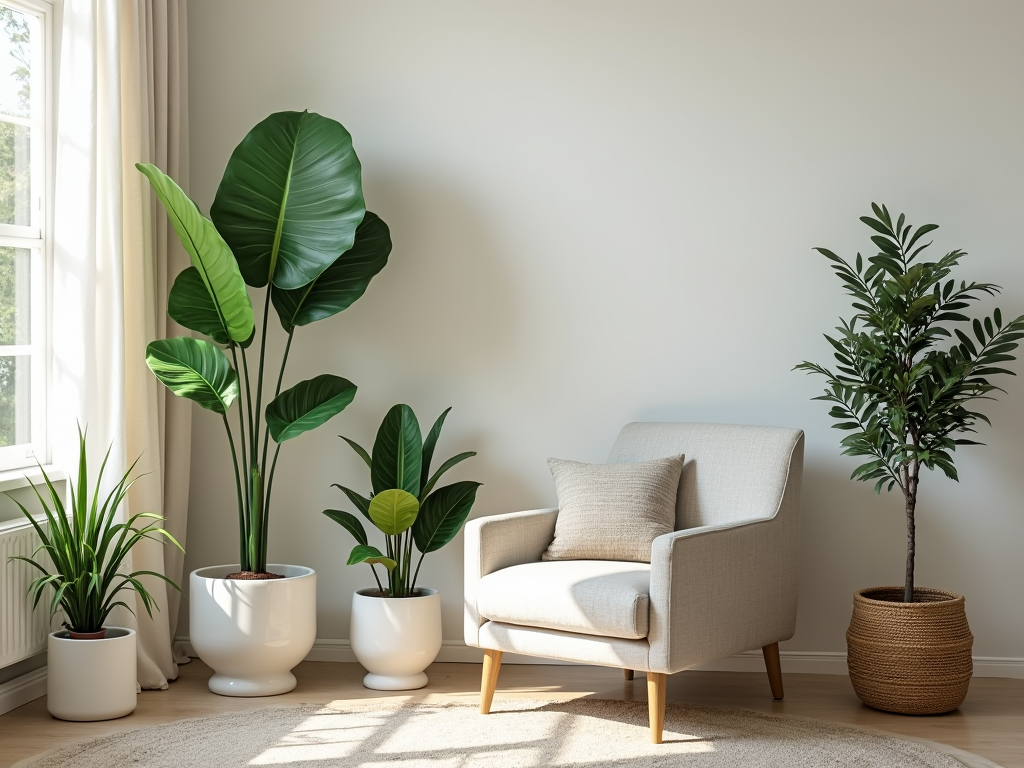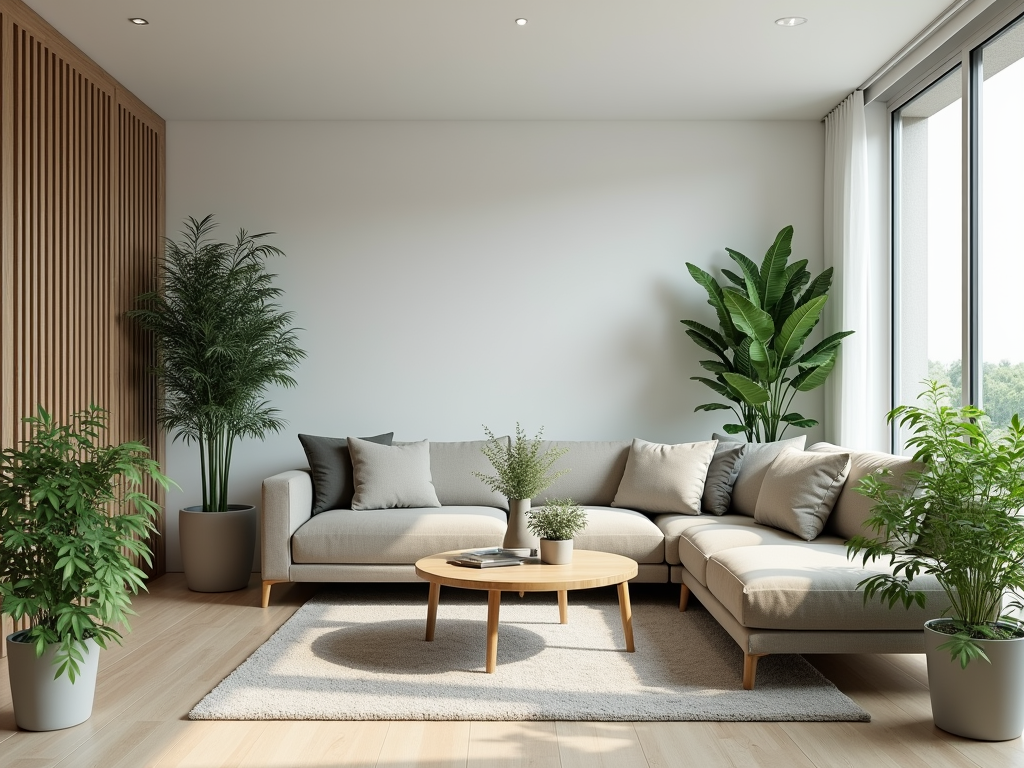
Key Takeaways
- The optimal artificial plant height is approximately two-thirds of your ceiling height.
- Standard 8-foot ceilings work best with 5 to 5.5-foot plants.
- For small spaces, choose tall, slim plants with bases under 12 inches wide.
- Leave at least 18 inches of walking space around the plant for good traffic flow.
- Select pots that are one-third to one-quarter of the plant’s total height for proper proportion.
Choosing the Right Height for Your Space
I find that rooms with standard 8-foot ceilings look best with plants between 5 to 5.5 feet tall. Higher ceilings of 10 feet or more can support taller specimens of 7 feet or higher. The proportions remain consistent regardless of room size.
Artificial Plants for Small Spaces
Small spaces need special consideration. I suggest picking slim, vertical plants with compact bases under 12 inches wide. This maintains the height impact while minimizing floor space usage. An 18-inch clearance around the plant ensures smooth movement through the space.
The Importance of Pot Size
The pot size also affects the overall look. I advise choosing containers that measure one-third to one-quarter of the total plant height. This creates a balanced, professional appearance that draws attention without overpowering the room.
The Perfect Height Formula for Your Space
I’ve found that selecting the right size artificial plant for your home makes a huge difference in creating visual impact. The perfect height depends on your ceiling height – a simple formula can help you nail the proportions every time.
Height Guidelines Based on Ceiling Height
Getting the scale right is crucial for decorating with artificial plants that look natural and balanced. Here’s a quick breakdown of ideal plant heights based on your ceiling:
- For standard 8-foot ceilings: Choose plants between 5 to 5.5 feet tall
- For 9-foot ceilings: Go with 6-foot plants
- For 10-foot ceilings or higher: Select plants at least 7 feet in height
- For lower 7-foot ceilings: Stick to plants under 4 feet tall
The magic ratio I use is roughly two-thirds of your ceiling height. This proportion creates visual balance while leaving enough breathing room above the plant. Too tall, and your space feels cramped. Too short, and the plant loses its impact as a focal point.
This ratio works whether you’re placing artificial plants outdoors or inside. For outdoor spaces without a defined ceiling, I measure against nearby structures like pergolas or overhangs to maintain proper scaling.
Remember to factor in any containers or raised platforms that might add height to your artificial plant. The total height, including the pot, should fit within these guidelines. I also consider furniture placement – a tall plant behind a low sofa can create stunning depth, while one next to a tall bookcase might need to be scaled down to avoid overcrowding.
These proportions aren’t just about aesthetics – they’re practical too. Keeping plants at these heights makes them easier to clean and maintain, plus they won’t interfere with lighting fixtures or ceiling fans. If you’re creating an artificial plant wall, these same principles apply to the overall composition height.
Space-Saving Solutions for Any Room Size
Small spaces don’t have to limit your decorating options with artificial plants. I’ve found that selecting the right size fake plant can actually make a room feel larger and more balanced.
Smart Plant Sizing for Your Space
For compact rooms, I recommend choosing tall, slim plants with a base under 12 inches wide. These narrow options create vertical interest without eating up precious floor space. A sleek palm or bamboo artificial plant can add height while maintaining an open feel.
Empty corners present perfect opportunities for taller statement pieces. I suggest placing a 6-7 foot plant to soften sharp angles and create a natural transition between walls. Remember to leave at least 18 inches of walking space around the plant to maintain good traffic flow.
In larger rooms, you can be more adventurous with fuller, bushier plants. These can serve as natural room dividers or create distinct zones in open-plan spaces. Here’s what I consider when placing plants in different areas:
- For entryways: Choose plants that are 1/3 the height of your ceiling.
- In living rooms: Position plants that reach just below window height.
- Near seating areas: Keep plants at or below eye level when seated.
- Behind furniture: Select plants that extend 12-24 inches above the furniture back.
To create visual harmony, I like arranging plants in a triangle pattern with existing furniture and wall decor. This technique draws the eye naturally around the room while maintaining balance. For optimal results, incorporating artificial plants at varying heights can add depth and dimension to your space.
Keep in mind that the pot’s diameter impacts the overall footprint. I subtract twice the pot’s width from the available floor space to ensure comfortable movement around the plant. This simple calculation helps prevent overcrowding while maximizing the plant’s visual impact.

Smart Pot Selection for Visual Impact
Selecting the perfect pot for your artificial plant arrangement makes a huge difference in its overall appearance. I’ve found that proportion is crucial – your pot should typically be one-third to one-quarter of your plant’s total height. This creates a balanced, eye-catching display that draws attention for all the right reasons.
Getting Your Measurements Right
Let’s break this down into practical terms. For a striking 6-foot artificial plant, I’d pick a pot between 18-24 inches tall. This height ratio ensures your artificial plant styling looks natural and well-proportioned. The pot’s width needs careful consideration too – it should match your plant’s fullness to prevent any wobbling or tipping.
Here’s what I consider essential when choosing the right pot:
- Match the pot style to your room’s decor – modern spaces work well with sleek ceramic options
- Pick materials that complement your existing furnishings – terracotta adds warmth while metallic finishes bring sophistication
- Consider the visual weight – lighter colored pots can make your space feel more open
- Factor in the pot’s base width for stability – wider bases work better for taller plants
- Think about texture – woven planters add organic appeal while glossy ceramics create modern sophistication
I always recommend upgrading from basic plastic containers. While they’re fine for temporary solutions, investing in quality decorative pots transforms artificial plants into stunning home features. Ceramic pots offer durability and style, terracotta brings natural charm, and woven planters add wonderful texture to your space.
Don’t forget that pot selection impacts more than just aesthetics – it’s also about creating a cohesive look in your space. I’ve seen how the right pot can turn a simple faux plant into a standout piece of decor. The key is treating your pot choice as carefully as you’d select any other piece of furniture or decor element in your room.
Popular Artificial Plants and Their Ideal Heights
Tall Statement Plants
I’ve found that selecting the right height for artificial plants in your space can dramatically impact their visual appeal. Fiddle Leaf Fig trees, standing proudly at 5-6 feet, create an impressive focal point in living rooms with standard 8-foot ceilings. Bird of Paradise plants take this a step further, reaching heights of 5-7 feet, making them perfect statement pieces for spacious entryways or corner spots.
Palm varieties offer fantastic flexibility in height options. Areca palms can soar up to 8 feet or higher, while Kentia palms provide a more moderate option at 4-6 feet. These artificial plants can transform any room with their tropical flair and commanding presence.
Medium to Small Options
For spaces that need a more subtle touch, I recommend considering these popular varieties and their heights:
- Snake Plants: 2-4 feet tall, perfect for narrow spaces or alongside furniture
- Monstera Deliciosa: 3-6 feet, adaptable to various room sizes
- ZZ Plants: 1-3 feet, ideal for desks or side tables
- Olive Trees: 4-7 feet, offering Mediterranean charm
The key is matching the plant’s height to your ceiling height and available floor space. I suggest keeping artificial plants about 2 feet shorter than your ceiling height for the best visual balance. This guideline helps maintain proportion while ensuring your fake plants look natural in your home.
For standard 8-foot ceilings, plants between 4-6 feet tall work best as main focal points. Smaller spaces can beautifully accommodate plants in the 2-4 foot range without feeling cramped. The versatility of artificial plants means you can position them exactly where needed without worrying about light requirements or growth patterns.
Sources:
The Spruce
Apartment Therapy
Bloomscape
Nearly Natural
